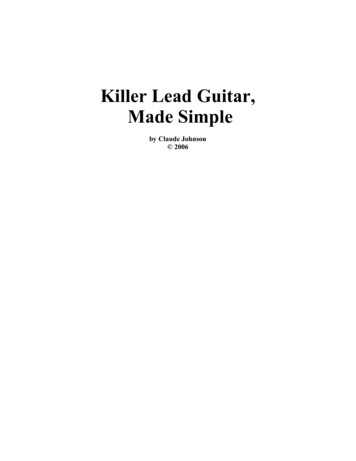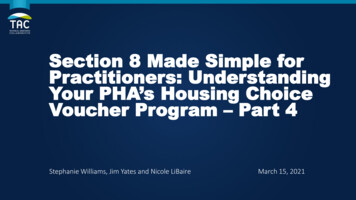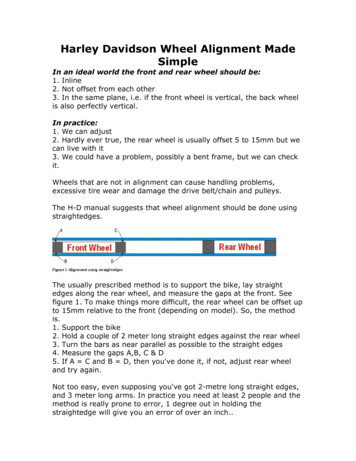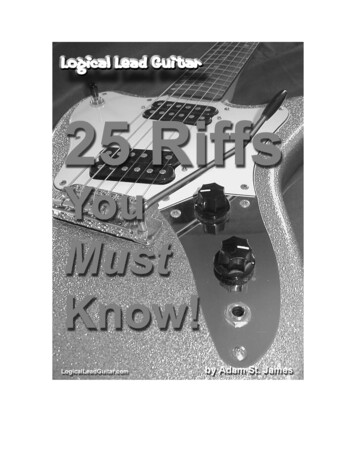
Transcription
Killer Lead Guitar,Made Simpleby Claude Johnson 2006
About this e-book: This is a guide-book that goes with Claude Johnson's instructional video, “Killer LeadGuitar Made Simple”. If you obtained this e-book any other way except buying the video, please inform asat admin@guitarcontrol.com. Thank you.TABLE OF .3How to Use this Course .4Getting Started .7Knowing Your Fretboard .8The Pentatonic Scale .9Practicing the Scale .11Alternate Picking & Other Techniques .12Shifting to Other Keys .14“Downloading” Essential Licks .15The Minor Scale .17Famous Guitar Solos .18Improvising .20How to Proceed .22
“I mean, the sound of an amplified guitar in a roomfull of people was so hypnotic and addictive to me,that I could cross any kind of border to get there"- Eric ClaptonINTRODUCTIONHi. My name is Claude Johnson, and guitar playing is my passion. It's been my passionfor the last 15 years. But even more than just guitar playing, I really enjoy lead guitarplaying. Yeah, chords are cool, rhythms and songwriting is cool, but to me, the realmagic is wailing away with a distorted tone, playing a wicked solo.Since very early on in my guitar career, my goal was to play smokin' lead guitar. Well,after many years of practice, and trial and error, I was able to do this. I started gettingbetter and I started playing in bands too. Eventually, this led me to persue a teachingcareer and production of my first instructional video, Killer Guitar Control Secrets. Thatvideo cuts to the essence of improvisational control.Now, I've sort of worked my way backwards from the advanced concepts in GuitarControl to this course, Killer Lead Guitar Made Simple. My teaching philosophy isbased on simplicity. I teach you what you need to know in order to start playing leadguitar, and I leave all out all the distractions.You can find an endless supply of exercises, techniques, concepts, etc in the guitarmagazines and books. And that's all fine and good. But thumbing through magazinesand playing the monthly lessons is not the fastest way for a beginner to learn. Yes, youwill learn some cool licks and tricks. But what the beginning lead guitar player needs isa simple method that cuts to the essence of things, leaves out distractions, eliminates trialand error, and shortcuts your learning.You know, most things in life are very simple. But, we tend to make them complicated.The sheer abudance of information that is available can be overwhelming. Where do youstart? What is really important to know?So that is what I'm trying to do in this course – teach you how to develop solid lead guitarskills – quickly, and without confusion.
How to Use this CourseThere is no right way to use this course. Some people learn better from a video, somefrom an audio, some from an ebook. Pick one and start with it and don't jump around.You might as well read the book first. Heck, you're already reading it. Go through itonce without your guitar, then once with your guitar. Then the audios, then the videos.By the time you get to the video, you'll already be progressing.Keep going back and forth until everything is clear to you and you know exactly what todo. Keep integrating the material from the DVD, the ebook, and the audios togetherwith your learning experience. Your lead guitar skills will naturally develop and growstronger and stronger the longer you play.The most important ingredient is the intention and dedication of the student.No Fluff!This e-book is short and exactly to the point. Remember, the whole point of thiscourse is SIMPLICITY. I could easily write 50 pages of guitar exercises to “pump up”the book and make it look like you're “getting more” material. But, more material is notwhat you need. Recall, there is an endless supply of material out there in the form ofbooks, magazines, other videos, etc.So the whole point is to remove the confusion and focus on the exact things you need toacquire lead guitar skills NOW.OverviewThere are 3 things you need to learn and practice. First, the scales. You will learn certainpatterns on the fretboard (Pentatonic Scale and Minor Scale). Secondly, you will learncertain techniques (Alternate Picking, String Bending, Vibrato, etc). Thirdly, You willlearn example licks from the DVD. A guitar “lick” is a short series of notes that makes amusical statement.
The example licks are the “Cliff Notes” of Guitar SoloingBack when I was in high school, we sometimes were assigned huge books to read inLiterature class. If we didn't have time to read the book, (or just didn't feel like it), wecould “cheat” by just reading the Cliff Notes. The Cliff Notes were sold seperately assmall booklets that summarize the essence of the real book.That's what learning these example licks will do for you. Instead of learning 20- 30complete guitar solos (which would take forever for the beginning student), I've extracted52 of the most fundamental and commonly used licks and phrases. By playing theselicks, your fingers and ears will get used to playing lead guitar fairly quickly.In addition, all of these licks are from the same basic pentatonic pattern. And this patternis going to be our focus of study for this course. So, you are already going to be learningquickly by keeping things simple and working toward mastering this ONE pattern.On top of that, you're going to use these “cliff note” licks to maximize your progress inthis pattern in record time.Melody vs. HarmonyIt is important to understand the difference between melody and harmony and how theyrelate to lead guitar playing.When you think of a popular song, the first thing that usually comes to mind is themelody. This is the basic tune of a song, often in the form of a vocal melody. Forexample, think of the song “Happy Birthday” or “The Star Spangled Banner”. Thesesongs have such obvious and strong melodies, that you can easily sing them a capella(without background instruments).A melody is a series of notes, one after another, and has a specific rhythm to it, alongwith a specific sequence of pitches. With “Happy Birthday”, the melody starts out, HAP– PY BIRTH-DAY TO YOUUUUU. Even the first six notes are instantly recognizable.Interestingly, “The Star Spangled Banner” also starts with an instantly recognizable sixnote phrase. OH -OH SAY CAN YOU SEEEEEE.The recognition comes as a consequence of the rhythm and the pitches.Harmony is the underlying chord progression of a song. Now, not every song has amelody that is as recgonizable as the examples both. For instance, “In My Life” by theBeatles, you may or may not recognize the melody if someone were to hum the first eightnotes. BUT, if you heard the background chords along with it, you'd probably recognizethe song instantly.To the non-musician, or to the untrained ear, most people just associate with the melody.
But the harmony is often equally important. The notes you play on the guitar will soundcompletely different based on what harmony is going on underneath.In other words, the same lick will sound completely different depending on what chordsyou play it over. In practice, the harmony helps define the melody, and this especiallytrue in guitar soloing.Guitar soloing is melodic – that is to say, it consists of a sequence of notes. You mightsay that melodies and guitar solos are 'horizontal' (laid out in a straight line) and thatchords and harmonies are 'vertical' (stacked up).Depending on what chords are being played, you can play in a different key to producegood-sounding musical phrases. In this way, melodic overlays and interacts with theharmony.All this is background knowledge. We will soon discover what it means in practicalterms.
Getting Started – What You NeedYou will need a decent electric guitar, a decent amplifier, a guitar pick, a patch chord,and an electronic tuner. All of these items can obtained cheaply from your local musicstore, or from an online retailer, such as Ebay.com.Notice I did not say a great guitar, or even a “nice” guitar. An inexpensive guitar cansound surprisingly good. For example, the guitar I used on the DVD for this course costme 139 plus shipping from Ebay. And it doesn't sound too bad at all! But you do needa decent guitar. If you have an old , crappy guitar, it will simply sound bad and yourprogress will be stunted, along with your motivation and enjoyment.You also need a decent amplifier that can produce a distorted tone. Again, you don't needto spend much money.Make sure your guitar has fairly new strings at all times. The effort is worth it becauseotherwise, old strings will turn your decent guitar into a crappy guitar!And you must be in tune. Use an electronic tuner when you are first getting started toavoid frustration. As you get better, you can tune by ear, which will improve your ear.You need a guitar pick. Although some guitarists get away with just playing with theirfingers, this is not my recommendation. I suggest using a medium to heavy pick.
Knowing Your FretboardFrom the bottom (low) string to the top (highest) string, The notes are E, A, D, G, B, andE. The notes on the fretboard are laid out like this:Eventually, you should try to memorize the fretboard as thoroughly as possible. For now,simply be aware of the general layout. Notice that between the notes B and C, there is nonote. Also, between E and F there is no note. Between F and G, there is a note whichcan either be called F# or Gb. (F sharp or G flat). Same thing with G and A, there is anote between them called G# or Ab. (Also a note exists between A and B, and betweenC and D, and also between D and E).Notice there are a total of 12 seperate notes that repeat all over the neck. These 12 notesare: ( A B C D E F G A# C# D# F# G#)
The Pentatonic ScaleWhat is a scale? A scale is a collection of notes. We have 12 notes in total, BUT we arenot going to be using all 12 at once. (What a relief!). In fact, we are going to only use 5notes at once, in various combinations.“Penta” means five. “Tonic” means tone. So, Pentatonic means playing 5 tones (ornotes) in various combinations.A pentatonic scale is not just any 5 notes though! (Although technically speaking, anycombination of 5 notes could theoretically be called “pentatonic”, it is common usage tomean a specific pattern of 5 notes, and it has a specific intervallic structure.)By “intervallic”, I am referring to the intervals, or distance between the notes. You canmeasure the distance between notes in terms of the number of frets. Two notes that arenext to each other on the fretboard on the same string are “one fret apart” (E and F. orD# and E, etc). This is also called a half-step. A whole step interval is a distance of twofrets – for example, G to A. Take a look at the fretboard diagram above until youunderstand what I mean about the intervals.If all this sounds complex, don't worry, we're going to bring this back down to earth herein a moment. All will be made clear, I promise.The “A” Pentatonic ScaleNow, lets look at a specific pentatonic scale – the “A” Pentatonic Scale. This scaleconsists of the notes A, C, D, E, and G. The notes are everywhere on the fretboard, but,we are NOT going to try to memorize the entire fretboard! Save that for the advancedcourse.We are going to memorize just ONE single pattern, in a specific position of the fretboard.Here's the pattern:
A lot simpler than trying to memorize it all over the neck! At later stages of your musicaldevelopment, you can do that, but for now, just this one pattern.And in fact, you don't even really have to memorize the notes at all when you'restarting out! Just memorize this shape:(Memorize the dots in red)To play this scale pattern, you would start out on the bottom string, fretting the low Awith the first finger on the 5th fret, then playing the C with the pinky on the 8th fret, thenmoving up to the next string, playing the 5th fret with the first finger and the 7th fret withthe ring finger.Because the pinky is the fourth finger and the ring finger is the third, I tend to think ofthis pattern in terms of “ONE – FOUR, ONE- THREE, ONE-THREE, ONE-THREE,ONE-FOUR, ONE-FOUR”.But you can think of the pattern however you want, as long as you get familiar with thebasic shape.
Practicing the ScaleIn a musical context, when you play a guitar solo, or even the example licks in thiscourse, you are going to be combinining the notes from the pattern into various musicalideas and phrases. The order of the notes will not be sequential necessarily. In otherwords, you are not going to start from the bottom of the scale and go to the top. Theorder of the notes
The Pentatonic Scale .9 Practicing the Scale .11 Alternate Picking & Other Techniques .12 Shifting to Other Keys .14 “Downloading” Essential Licks .15 The Minor Scale .17 Famous Guitar Solos .18 Improvising .20 How to Proceed .22 “I mean, the sound of an amplified guitar in a room full of people was so hypnotic and addictive to me, that I could cross .











